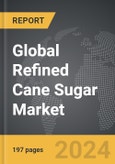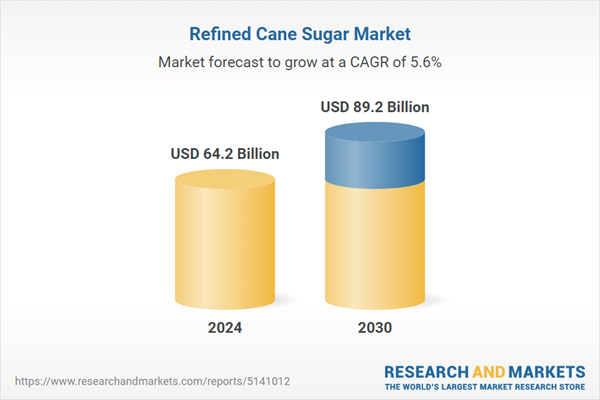Global Refined Cane Sugar Market - Key Trends and Drivers Summarized
Why Is Refined Cane Sugar So Central to the Global Food Industry?
Refined cane sugar remains a fundamental ingredient in the global food industry, deeply embedded in both household cooking and large-scale food manufacturing processes. It is derived from sugarcane through a series of extraction, purification, and crystallization processes, resulting in the pure, white, crystalline sugar that dominates the market. Its widespread use is attributed to its versatility as a sweetener, preservative, and texture enhancer. Refined cane sugar can be found in countless products, including baked goods, confectioneries, beverages, sauces, and even pharmaceuticals. The food and beverage industry relies heavily on its flavor-enhancing properties and its ability to provide bulk and texture to products, particularly in mass production environments. Additionally, sugar's role in preserving food by preventing microbial growth extends the shelf life of processed foods, making it indispensable for manufacturers. Despite the ongoing debates about the health implications of excessive sugar consumption, refined cane sugar continues to be a mainstay in global diets. This ubiquitous presence ensures that it remains a key commodity, consistently in demand across various sectors, from domestic use to large-scale industrial production.How Is the Market for Refined Cane Sugar Evolving?
The market for refined cane sugar is undergoing significant evolution, shaped by changing consumer preferences, health trends, and regulatory pressures. Increasing awareness of the health risks associated with high sugar intake, including obesity, diabetes, and heart disease, has led to a global shift towards reducing sugar consumption. Governments around the world have implemented sugar taxes and stricter labeling requirements, pressuring food manufacturers to reformulate products with lower sugar content or alternative sweeteners. Despite these shifts, refined cane sugar continues to hold a strong position, particularly in markets where sugary foods and beverages remain culturally ingrained. For instance, regions like Asia, Latin America, and parts of Africa continue to see rising demand for soft drinks, sweets, and processed foods that rely heavily on refined sugar. Moreover, the growing middle-class populations in developing economies are driving increased consumption of processed and convenience foods, further boosting demand for sugar as an essential ingredient. While health-conscious consumers in developed markets are opting for low-sugar or sugar-free products, the global demand for refined cane sugar remains resilient, particularly in areas where traditional diets and lifestyle preferences still dominate.What Are the Emerging Trends and Challenges in Refined Cane Sugar Production?
The production of refined cane sugar is increasingly being influenced by global trends in sustainability, technological advancements, and shifts in consumer behavior. One of the most significant trends is the rising demand for sustainably sourced and ethically produced sugar. Consumers, particularly in developed markets, are becoming more conscious of the environmental and social impact of the products they buy, leading to a growing market for fair trade, organic, and sustainably farmed cane sugar. Producers are responding by adopting more environmentally friendly practices, such as improving water conservation during refining processes and reducing the carbon footprint of sugar production. However, the sugar industry faces challenges due to the resource-intensive nature of sugar refining, which requires large amounts of water, energy, and land. Additionally, fluctuating commodity prices and the volatility of global sugar markets present ongoing economic challenges for producers. At the same time, the rise of sugar alternatives, driven by consumer preferences for healthier options, poses a competitive threat to traditional cane sugar. While refined cane sugar remains essential in many food products, producers must adapt to these challenges by investing in innovative technologies that reduce production costs and improve sustainability while navigating an increasingly regulated market landscape.What Factors Are Driving Growth in the Refined Cane Sugar Market?
The growth in the refined cane sugar market is driven by several factors, particularly the continued expansion of the food and beverage industry, technological advancements in production, and evolving consumer behavior. One of the primary drivers is the growing demand for processed and convenience foods, particularly in rapidly urbanizing regions such as Asia-Pacific, Latin America, and Africa. As urban populations increase, so does the consumption of packaged foods and beverages, many of which use refined cane sugar as a core ingredient. The beverage industry, especially in developing economies, continues to be a significant consumer of refined cane sugar, with soft drinks, energy drinks, and sweetened juices contributing to steady demand. Technological advancements in refining processes, such as energy-efficient methods and automation, have also contributed to market growth by improving production efficiency and reducing operational costs. Furthermore, while many health-conscious consumers are turning to alternative sweeteners, a substantial portion of the global population still favors traditional sweetened products, ensuring ongoing demand for cane sugar in baking, confectionery, and beverage applications. Additionally, the rise of niche markets, including organic and non-GMO cane sugar, presents new opportunities for producers to tap into premium segments. Finally, favorable trade policies and export opportunities, particularly from major producing countries like Brazil, India, and Thailand, are expanding the global reach of refined cane sugar, ensuring its sustained growth in various international markets.Report Scope
The report analyzes the Refined Cane Sugar market, presented in terms of market value (USD). The analysis covers the key segments and geographic regions outlined below.- Segments: Product Type (Liquid Sugar, Granulated Textured Sugar, Powdered Sugar, Pulp, Other Product Types).
- Geographic Regions/Countries: World; United States; Canada; Japan; China; Europe (France; Germany; Italy; United Kingdom; Spain; Russia; and Rest of Europe); Asia-Pacific (Australia; India; South Korea; and Rest of Asia-Pacific); Latin America (Argentina; Brazil; Mexico; and Rest of Latin America); Middle East (Iran; Israel; Saudi Arabia; United Arab Emirates; and Rest of Middle East); and Africa.
Key Insights:
- Market Growth: Understand the significant growth trajectory of the Liquid Sugar segment, which is expected to reach US$24 Billion by 2030 with a CAGR of 6.6%. The Granulated Textured Sugar segment is also set to grow at 5.3% CAGR over the analysis period.
- Regional Analysis: Gain insights into the U.S. market, valued at $16.6 Billion in 2024, and China, forecasted to grow at an impressive 8.9% CAGR to reach $21 Billion by 2030. Discover growth trends in other key regions, including Japan, Canada, Germany, and the Asia-Pacific.
Why You Should Buy This Report:
- Detailed Market Analysis: Access a thorough analysis of the Global Refined Cane Sugar Market, covering all major geographic regions and market segments.
- Competitive Insights: Get an overview of the competitive landscape, including the market presence of major players across different geographies.
- Future Trends and Drivers: Understand the key trends and drivers shaping the future of the Global Refined Cane Sugar Market.
- Actionable Insights: Benefit from actionable insights that can help you identify new revenue opportunities and make strategic business decisions.
Key Questions Answered:
- How is the Global Refined Cane Sugar Market expected to evolve by 2030?
- What are the main drivers and restraints affecting the market?
- Which market segments will grow the most over the forecast period?
- How will market shares for different regions and segments change by 2030?
- Who are the leading players in the market, and what are their prospects?
Report Features:
- Comprehensive Market Data: Independent analysis of annual sales and market forecasts in US$ Million from 2024 to 2030.
- In-Depth Regional Analysis: Detailed insights into key markets, including the U.S., China, Japan, Canada, Europe, Asia-Pacific, Latin America, Middle East, and Africa.
- Company Profiles: Coverage of players such as AB Achema, Agrigro Inc., AZOMITE Mineral products, Inc., CF Industries Holdings, Inc., Clariant International Ltd. and more.
- Complimentary Updates: Receive free report updates for one year to keep you informed of the latest market developments.
Some of the 48 companies featured in this Refined Cane Sugar market report include:
- AB Achema
- Agrigro Inc.
- AZOMITE Mineral products, Inc.
- CF Industries Holdings, Inc.
- Clariant International Ltd.
- Coromandel International Ltd.
- Dayal Group
- Forbon Technology
- Frit Industries Inc.
- Hydro Fert s.r.l.
- ICL Fertilizers
- Liven Agrichem Pvt Ltd
- Novochem Group
- OCP SA
- Sinofert Holdings Limited
- Tata Chemicals Limited
- The DuPont Company
- The Mosaic Company
- Yara International ASA
This edition integrates the latest global trade and economic shifts into comprehensive market analysis. Key updates include:
- Tariff and Trade Impact: Insights into global tariff negotiations across 180+ countries, with analysis of supply chain turbulence, sourcing disruptions, and geographic realignment. Special focus on 2025 as a pivotal year for trade tensions, including updated perspectives on the Trump-era tariffs.
- Adjusted Forecasts and Analytics: Revised global and regional market forecasts through 2030, incorporating tariff effects, economic uncertainty, and structural changes in globalization. Includes historical analysis from 2015 to 2023.
- Strategic Market Dynamics: Evaluation of revised market prospects, regional outlooks, and key economic indicators such as population and urbanization trends.
- Innovation & Technology Trends: Latest developments in product and process innovation, emerging technologies, and key industry drivers shaping the competitive landscape.
- Competitive Intelligence: Updated global market share estimates for 2025, competitive positioning of major players (Strong/Active/Niche/Trivial), and refined focus on leading global brands and core players.
- Expert Insight & Commentary: Strategic analysis from economists, trade experts, and domain specialists to contextualize market shifts and identify emerging opportunities.
Table of Contents
Companies Mentioned (Partial List)
A selection of companies mentioned in this report includes, but is not limited to:
- AB Achema
- Agrigro Inc.
- AZOMITE Mineral products, Inc.
- CF Industries Holdings, Inc.
- Clariant International Ltd.
- Coromandel International Ltd.
- Dayal Group
- Forbon Technology
- Frit Industries Inc.
- Hydro Fert s.r.l.
- ICL Fertilizers
- Liven Agrichem Pvt Ltd
- Novochem Group
- OCP SA
- Sinofert Holdings Limited
- Tata Chemicals Limited
- The DuPont Company
- The Mosaic Company
- Yara International ASA
Table Information
| Report Attribute | Details |
|---|---|
| No. of Pages | 197 |
| Published | December 2025 |
| Forecast Period | 2024 - 2030 |
| Estimated Market Value ( USD | $ 64.2 Billion |
| Forecasted Market Value ( USD | $ 89.2 Billion |
| Compound Annual Growth Rate | 5.6% |
| Regions Covered | Global |









